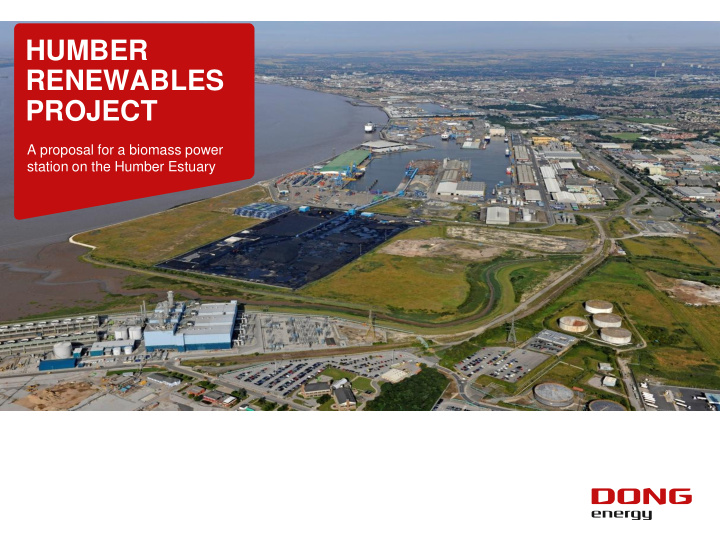



HUMBER RENEWABLES PROJECT A proposal for a biomass power station on the Humber Estuary
Agenda Background – who is DONG Energy? – what is the need for a new power station? – why here? The Proposal – what’s involved? – what is biomass? Application Process – what will happen and when Consultation – outline of process – feedback routes
Who we are DONG Energy is one of the leading energy groups in Northern Europe Headquartered in Denmark Buys, produces, distributes and trades in energy and related products Employs approx 6,000 people full time Revenue of approx. 6.6 billion Euros in 2009 Long-term goal: to provide reliable energy without CO 2
Why we need new power stations Many of the UK’s existing coal fired and nuclear power stations are reaching the end of their working life Burning fossil fuels creates greenhouse gases that cause climate change (The Renewable Energy Association estimates that more than 7 billion tonnes of carbon dioxide are emitted globally each year through fossil fuel use) Demand for electricity has not decreased significantly, despite the introduction of energy efficiency programmes The UK has set a target of generating 15% of its energy from renewable sources by 2020 – biomass is a renewable fuel
Why choose Hull? Hull already plays a role in the UK energy sector It has an established power and transport infrastructure Population has knowledge and expertise in energy generation Access to the sea allows transportation of fuel in large quantities with no impact on local road or rail network
What is being proposed? A new power station on the north shore of the Humber Regeneration of a currently vacant site adjacent to Queen Elizabeth Dock The use of biomass - primarily clean woodchips or wood pellets.
What is biomass? Biomass is an alternative to fossil fuels It is a renewable fuel source because it is largely derived from plants Biomass can come from plantations where it is grown specifically as a fuel It can also include residues from forestry and agriculture It is largely carbon neutral, so it helps to combat global warming
What will the plant look like? Because we are consulting early, we do not have a lot of detail yet, but: It will take up an area of about 92,000m 2 (the size of 13 rugby pitches) It will include a main turbine building, fuel reception and storage area, boiler house, stack, administrative buildings, etc Main buildings will be no higher than 100m It will generate just under 300MW electricity (enough to meet the average needs for up to ½ million homes)
Where will the fuel come from? The biomass fuel will come from a sustainable source The biomass is intended primarily to be a combination of woodchips and wood pellets The wood for the power station will mainly come from abroad Small quantities could also be sourced locally The fuel will arrive at the site by ship and be offloaded at the deep water jetty that ABP is developing nearby.
What about emissions? All power stations create emissions and the Humber Renewables Project is no exception However, the combustion of clean woodchip and wood pellets creates relatively low emissions compared to conventional power stations The power station will use Best Available Techniques (BAT) to ensure that emissions do not present a risk to local people or the environment Emissions associated with fuel transportation will be greatly reduced because most of the biomass will arrive in very large ships that can hold up to 100,000 tonnes each trip
What is the application process? Because it will generate more than 50MW, the Humber Renewables Project is classed as a Nationally Significant Infrastructure Project (NSIP) The Infrastructure Planning Commission (IPC) decides whether or not this type of project can be built The application process says that people who live and work near the proposed power station should be consulted from an early stage. This matches DONG Energy’s own approach to consultation The views of local people will be taken into account when developing more detailed proposals If the IPC is not satisfied that sufficient consultation has taken place, it may not give permission for the power station to be built
What is the consultation process? DONG Energy aims to develop a dialogue with local people from a very early stage The consultation is to find out what people think about the proposal for the biomass power station The design of the station will be made taking these views into consideration All the responses will be recorded in a Consultation Report which will be published later in the year The Consultation Report will form part of the formal application for development consent Full details of the consultation process are given in the Statement of Community Consultation
How will we conduct consultation? Through two-way discussion, such as: Briefing meetings like this one Public exhibitions or roadshows Stakeholder meetings We’d also like to establish a community liaison group Through provision of information, such as: Advertising and editorial in the local press Printed materials (brochures, etc) The project website
Feedback routes Write to us at FREEPOST HUMBER RENEWABLES (no stamp required) Email your views to humberrenewables@dongenergy.co.uk Feed back via the form on the website www.humberrenewables.co.uk
Thank you for listening Do you have any questions?
Recommend
More recommend